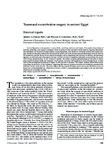|
|
Creator | Title | Description | Subject | Date |
| 1 |
 |
Couldwell, William T. | Ganglion cyst of the temporomandibular joint with intracranial extension in a patient presenting with seventh cranial nerve palsy | Ganglion cysts arising from the temporomandibular joint are rare entities that often present with swelling and minimal to no pain in the preauricular region. To the Author's? knowledge, a temporomandibular joint ganglion cyst occurring with acute facial nerve palsy and intracranial extension has ne... | | 2012 |
| 2 |
 |
Couldwell, William T. | Increasing exposure of the petrous internal carotid artery for revascularization using the transzygomatic extended middle fossa approach: a cadaveric morphometric study | When internal carotid artery (ICA) sacrifice is planned in the management of difficult tumors or aneurysms at the cranial base, the petrous ICA may be a useful site for anastomosis for interpositional vascular bypass. However, exposure of the artery and performing an anastomosis in this region may... | Revascularization; Internal carotid artery; Cranial base tumors; Giant aneurysms; Interpositional bypass; Surgical approach; Middle fossa | 2006 |
| 3 |
 |
Couldwell, William T. | Unruptured posterior communicating artery aneurysm presenting with gustatory seizures and temporal lobe edema | Unruptured cerebral aneurysms presenting with seizures are unusual. We describe a case of a growing middle cerebral artery aneurysm presenting with gustatory seizures with magnetic resonance imaging showing peri-aneurysmal edema. This case is the first to show temporal lobe edema associated with inc... | Seizure; Brain edema; PCOM | 2009-04 |
| 4 |
 |
Couldwell, William T. | Cholesteatoma of the clivus case report | Objective: Cholesteatomas (CNS epidermoids) can be found intradurally or extradurally in the central nervous system. Extradural intraosseous lesions are most commonly found in the petrous bone. Design: Case report Clinical Presentation: The authors describe a unique case of a clival cholesteatoma o... | | 2006-01-01 |
| 5 |
 |
Couldwell, William T. | Surgical approaches for resection of vestibular schwannomas: Translabyrinthine, retrosigmoid, and middle fossa approaches | Surgical removal remains one of the key treatment modalities for vestibular schwannomas. A team approach between a neurotologist and a neurosurgeon offers the patient the expertise of both specialties and maximizes the chances for an optimal outcome. Vestibular schwannomas can typically be resected ... | | 2012-01-01 |
| 6 |
 |
Couldwell, William T. | Far Lateral Transcondylar Approach for Resection of Neurenteric Cysts of the Cervicomedullary Junction (Far-lateral transcondylar approach: surgical technique and its application in neurenteric cysts of the cervicomedullary junction. Report of two cases.) | Neurenteric cysts are rare benign lesions of the central nervous system that are lined by endodermal cell-derived epithelium. Although they occur mostly in the spine, they can occur intracranially, most often in the posterior fossa. Neurenteric cysts that are located in the anterior cervicomedullary... | Cervical Vertebrae; Medulla Oblongata; Neural Tube Defects; Neurosurgical Procedure | 2005-08-15 |
| 7 |
 |
Couldwell, William T.; House, Paul A. | De novo fenestration of the optic nerve | Fenestration of the optic nerve or chiasm due to the presence of an aneurysmal dilation of the internal carotid artery (ICA) has been described previously. In three of five cases reviewed recently, the optic nerve was penetrated by an ICA?ophthalmic artery aneurysm.3 Penetration of the optic nerve w... | Fenestration; Aneurysm | 2005 |
| 8 |
 |
Couldwell, William T.; MacDonald, Joel D. | Surgical strategies for recurrent craniofacial meningiomas | Recurrent cranial base meningiomas are among the most difficult tumors to treat surgically. Although they are histologically benign, these tumors often invade through the cranial base into the infratemporal and pterygopalatine fossae. We reviewed our experience with these tumors to describe the nat... | Craniofacial meningiomas; Recurrence; Cranial base tumor; Neoplasm | 2006 |
| 9 |
 |
Patel, Bhupendra C. | Lateral orbital wall approach to the cavernous sinus: laboratory investigation | Object. Lesions of the cavernous sinus remain a technical challenge. The most common surgical approaches involve some variation of the standard frontotemporal craniotomy. Here, the authors describe a surgical approach to access the cavernous sinus that involves the removal of the lateral orbital wal... | | 2012-01-01 |
| 10 |
 |
Couldwell, William T. | Submandibular high-flow bypass in the treatment of skull base lesions: an analysis of long-term outcome | Background: Cerebral bypass surgery remains an integral part of the treatment of complex skull base tumors and unclippable aneurysms. Objective: The authors retrospectively analyzed a single-surgeon experience using a high-flow submandibular-infratemporal saphenous vein graft bypass technique after ... | | 2012-01-01 |
| 11 |
 |
Couldwell, William T. | Transnasal excerebration surgery in ancient Egypt: Historical vignette | Ancient Egyptians were pioneers in many fields, including medicine and surgery. Our modern knowledge of anatomy, pathology, and surgical techniques stems from discoveries and observations made by Egyptian physicians and embalmers. In the realm of neurosurgery, ancient Egyptians were the first to elu... | | 2012-01-01 |
| 12 |
 |
Couldwell, William T.; Davidson, H. Christian | Trigeminal amyloidoma: case report and review of the literature | The authors present a case of amyloid infiltration involving the trigeminal nerve that mimicked a malignant cavernous sinus tumor with perineural tumor infiltration. A 64-year-old man presented with trigeminal nerve numbness. Imaging revealed a plaque-like enhancing lesion along the right lateral ca... | Gasserian ganglion; Trigeminal; Amyloidoma | 2007 |
| 13 |
 |
Couldwell, William T. | Recurrent infrasellar clival craniopharyngioma | The patient is a 44-year-old man who underwent resection of a posterior nasopharynx tumor 12 years earlier via left lateral rhinotomy approach. The final pathological analysis indicated the tumor was a craniopharyngioma, and the patient subsequently underwent focal radiation. The patient returned t... | Ectopic Craniopharyngioma; Recurrence; Infrasellar; Clivus | 2007 |
| 14 |
 |
Couldwell, William T. | Intracranial hypotension as a complication of lumbar puncture prior to elective aneurysm clipping | Background: Lumbar dural defects are an uncommon but important cause of persistent intracranial hypotension in the neurosurgical population. We present a case of intracranial hypotension after elective craniotomy due to a lumbar puncture performed 3 weeks earlier. Case Description: A 55‑year‑old... | | 2014-01-01 |
| 15 |
 |
Couldwell, William T. | Efficacy of clip-wrapping in treatment of complex pediatric aneurysms | Purpose: Pediatric aneurysms (PAs) are distinct from their adult counterparts with respect to typical location, aneurysm type, and known predisposing risk factors. Many strategies have been employed to treat PAs, but, although it has been used frequently in adults, clip-wrapping in pediatric patient... | | 2012-01-01 |
| 16 |
 |
Rogers, Alan R.; Harpending, Henry C. | Genetic structure of ancient human populations | Discusses mitochondrial DNA (mtDNA) sequences as important source of data about the history of human species. | Tree of descent; Mismatch distributions; Simulations; Findings; Intermatch distributions; Younger and older populations | 2001-09-15 |
| 17 |
 |
Couldwell, William T. | Hearing restoration after resection of an intracanalicular vestibular schwannoma: a role for emergency surgery? | Patients with vestibular schwannomas (VSs) most commonly present with sensorineural hearing loss, which is often insidious or gradual. Up to 26% of patients may present with sudden hearing loss, however, which poses an important surgical challenge. Sudden hearing loss has been attributed to spasm or... | Vestibular schwannoma; Hearing preservation | 2002 |
| 18 |
 |
Couldwell, William T. | Delayed vasospasm after removal of a skull base meningioma | Cerebral vasospasm is a well-known clinical entity associated with subarachnoid hemorrhage and traumatic brain injury [1,2]. In rare instances, vasospasm has been reported to occur after tumor resections, more specifically, after skull base tumor removal [3-5]. We report a rare case of a patient pre... | | 2012-01-01 |
| 19 |
 |
Couldwell, William T. | Resolution of an anterior-inferior cerebellar artery feeding aneurysm with the treatment of a transverse-sigmoid dural arteriovenous fistula | The authors describe a 27-year old man who developed an unruptured anterior-inferior cerebellar artery feeding aneurysm from a transverse-sigmoid dAVF and its subsequent resolution with the treatment of the dAVF. The patient, with a known history of left transverse and sigmoid sinus thrombosis, pres... | Aneurysms; Dural Arteriovenous Fistulas; Endovascular therapy; Surgery | 2007 |
| 20 |
 |
Couldwell, William T. | Harvey cushing and oskar hirsch: early forefathers of modern transsphenoidal surgery | The transnasal transsphenoidal approach is the preferred route for removal of most lesions of the sella turcica. The concept of transnasal surgery traversing the sphenoid sinus to reach the sella has existed for nearly a century. A comprehensive historical overview of the evolution of transsphenoida... | | 2005 |
| 21 |
 |
Couldwell, William T.; Apfelbaum, Ronald I. | Transoral approach and extended modifications for lesions of the ventral foramen magnum and craniovertebral junction | Objectives: To describe our method of performing the transoral approach and the extended approaches to the ventral foramen magnum and craniovertebral junction and review the technical aspects and operative nuances. Design: Review Results: The transoral approach provides direct midline exposure to a... | Craniovertebral junction; Foramen magnum; Skull base surgery; Transoral approach | 2008 |
| 22 |
 |
Couldwell, William T. | Thrombosed Basilar Apex Aneurysm presenting as a third ventricular mass and hydrocephalus: case report and review of the literature | Aneurysms presenting as third ventricular masses are uncommon; most are giant aneurysms arising from the basilar apex. We present a case of a thrombosed basilar apex aneurysm presenting as a third ventricular mass and hydrocephalus in a 55-year-old man. The case is unique in the literature as the an... | Basilar Apex Aneurysm; Ventricular Mass; Third Ventriculostomy | 2005-04 |
| 23 |
 |
Rogers, Alan R. | How much can fossils tell us about regional continuity? | Presents a study on the genetic contribution of earlier populations to later populations within regions called regional continuity. Testing for regional continuity with multiple characters; Replacement of archaic population by a population of modern humans. | Human genetics; Fossils; Regional continuity | 2006-06-05 |
| 24 |
 |
Couldwell, William T. | Thrombosed basilar apex aneurysm presenting as a third ventricular mass and hydrocephalus | Aneurysms presenting as third ventricular masses are uncommon; most are giant aneurysms arising from the basilar apex. We present a case of a thrombosed basilar apex aneurysm presenting as a third ventricular mass and hydrocephalus in a 55-year-old man. The case is unique in the literature as the an... | Basilar apex aneurysm; Ventricular mass; Third ventriculostomy | 2005 |
| 25 |
 |
Couldwell, William T. | William Osler at McGill University: the baby professor and his early contributions to neurosurgery | Between 1870 and 1884, as both a medical student and a member of the faculty, Sir William Osler performed approximately 1000 postmortem examinations at McGill University in Montreal. He conducted 786 of these examinations during his 7 years (1877-1884) of service as a pathologist at the M were caref... | | 2004-10 |

























